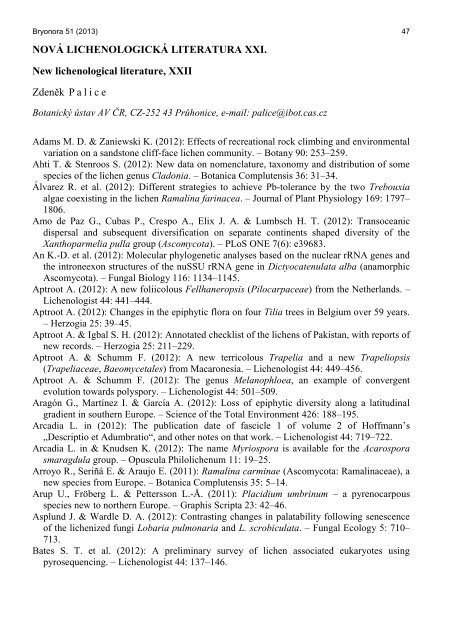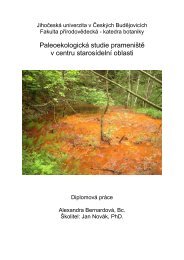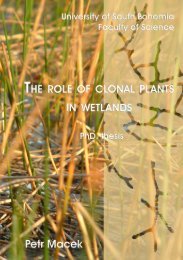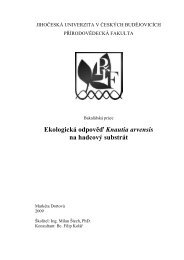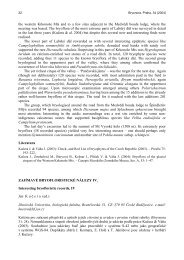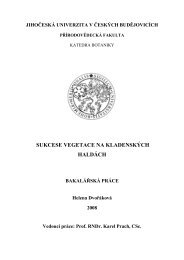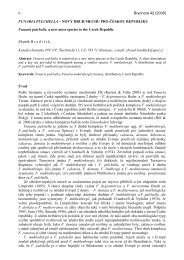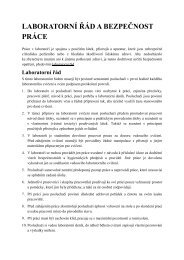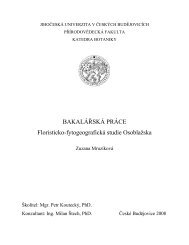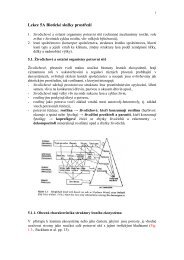NOVÁ LICHENOLOGICKÁ LITERATURA XXI. New lichenological ...
NOVÁ LICHENOLOGICKÁ LITERATURA XXI. New lichenological ...
NOVÁ LICHENOLOGICKÁ LITERATURA XXI. New lichenological ...
You also want an ePaper? Increase the reach of your titles
YUMPU automatically turns print PDFs into web optimized ePapers that Google loves.
Bryonora 51 (2013) 47<br />
<strong>NOVÁ</strong> <strong>LICHENOLOGICKÁ</strong> <strong>LITERATURA</strong> <strong>XXI</strong>.<br />
<strong>New</strong> <strong>lichenological</strong> literature, <strong>XXI</strong>I<br />
Zdeněk P a l i c e<br />
Botanický ústav AV ČR, CZ-252 43 Průhonice, e-mail: palice@ibot.cas.cz<br />
Adams M. D. & Zaniewski K. (2012): Effects of recreational rock climbing and environmental<br />
variation on a sandstone cliff-face lichen community. – Botany 90: 253–259.<br />
Ahti T. & Stenroos S. (2012): <strong>New</strong> data on nomenclature, taxonomy and distribution of some<br />
species of the lichen genus Cladonia. – Botanica Complutensis 36: 31–34.<br />
Álvarez R. et al. (2012): Different strategies to achieve Pb-tolerance by the two Trebouxia<br />
algae coexisting in the lichen Ramalina farinacea. – Journal of Plant Physiology 169: 1797–<br />
1806.<br />
Amo de Paz G., Cubas P., Crespo A., Elix J. A. & Lumbsch H. T. (2012): Transoceanic<br />
dispersal and subsequent diversification on separate continents shaped diversity of the<br />
Xanthoparmelia pulla group (Ascomycota). – PLoS ONE 7(6): e39683.<br />
An K.-D. et al. (2012): Molecular phylogenetic analyses based on the nuclear rRNA genes and<br />
the introneexon structures of the nuSSU rRNA gene in Dictyocatenulata alba (anamorphic<br />
Ascomycota). – Fungal Biology 116: 1134–1145.<br />
Aptroot A. (2012): A new foliicolous Fellhaneropsis (Pilocarpaceae) from the Netherlands. –<br />
Lichenologist 44: 441–444.<br />
Aptroot A. (2012): Changes in the epiphytic flora on four Tilia trees in Belgium over 59 years.<br />
– Herzogia 25: 39–45.<br />
Aptroot A. & Igbal S. H. (2012): Annotated checklist of the lichens of Pakistan, with reports of<br />
new records. – Herzogia 25: 211–229.<br />
Aptroot A. & Schumm F. (2012): A new terricolous Trapelia and a new Trapeliopsis<br />
(Trapeliaceae, Baeomycetales) from Macaronesia. – Lichenologist 44: 449–456.<br />
Aptroot A. & Schumm F. (2012): The genus Melanophloea, an example of convergent<br />
evolution towards polyspory. – Lichenologist 44: 501–509.<br />
Aragón G., Martínez I. & García A. (2012): Loss of epiphytic diversity along a latitudinal<br />
gradient in southern Europe. – Science of the Total Environment 426: 188–195.<br />
Arcadia L. in (2012): The publication date of fascicle 1 of volume 2 of Hoffmann’s<br />
„Descriptio et Adumbratio“, and other notes on that work. – Lichenologist 44: 719–722.<br />
Arcadia L. in & Knudsen K. (2012): The name Myriospora is available for the Acarospora<br />
smaragdula group. – Opuscula Philolichenum 11: 19–25.<br />
Arroyo R., Seriñá E. & Araujo E. (2011): Ramalina carminae (Ascomycota: Ramalinaceae), a<br />
new species from Europe. – Botanica Complutensis 35: 5–14.<br />
Arup U., Fröberg L. & Pettersson L.-Å. (2011): Placidium umbrinum – a pyrenocarpous<br />
species new to northern Europe. – Graphis Scripta 23: 42–46.<br />
Asplund J. & Wardle D. A. (2012): Contrasting changes in palatability following senescence<br />
of the lichenized fungi Lobaria pulmonaria and L. scrobiculata. – Fungal Ecology 5: 710–<br />
713.<br />
Bates S. T. et al. (2012): A preliminary survey of lichen associated eukaryotes using<br />
pyrosequencing. – Lichenologist 44: 137–146.
48 Bryonora 51 (2013)<br />
Beck A. & Mayr C. (2012): Nitrogen and carbon isotope variability in the green-algal lichen<br />
Xanthoria parietina and their implications on mycobiont–photobiont interactions. – Ecology<br />
and Evolution 2: 3132–3144.<br />
Beckett R. P., Minibayeva F. V. & Liers C. (2012): Occurrence of high tyrosinase activity in<br />
the non-Peltigeralean lichen Dermatocarpon miniatum (L.) W. Mann. – Lichenologist 44:<br />
827–832.<br />
Bennett J. P., Rodriguez C. M. & Johnson C. J. (2012): Prion protein degradation by lichens of<br />
the genus Cladonia. – Lichenologist 44: 523–531.<br />
Berger S. A., Stamatakis A. & Lücking R. (2011): Morphology-based phylogenetic binning of<br />
the lichen genera Graphis and Allographa (Ascomycota: Graphidaceae) using molecular<br />
site weight calibration. – Taxon 60: 1450–1457.<br />
Bomble F. W. (2012): Candelaria pacifica und Xanthomendoza borealis im Aachener Raum –<br />
neu für Deutschland. – Veröffentlichungen Bochumer Botanischer Verein 4(1): 1–8.<br />
Boudreault C., Bergeron Y. & Coxson D. (2012): Epiphytic lichen colonization in regenerating<br />
black spruce forest stands of clearcut origin. – Forest Ecology and Management 276: 247–<br />
258.<br />
Braidwood D. & Ellis C. J. (2012): Bioclimatic equilibrium for lichen distributions on disjunct<br />
continental landmasses. – Botany 90: 1316–1325.<br />
Breuss O. (2012): Bemerkenswerte Flechtenfunde aus den Karnischen Alpen (Kärnten,<br />
Österreich). – Herzogia 25: 103–108.<br />
Brodo I. M. & Lendemer J. C. (2012): On the perplexing variability of reproductive modes in<br />
the genus Ochrolechia: Notes on O. africana and O. arborea in eastern North America. –<br />
Opuscula Philolichenum 11: 120–134.<br />
Brunialti G. et al. (2012): Can we compare lichen diversity data? A test with skilled teams. –<br />
Ecological Indicators 23: 509–516.<br />
Buck W. R. & Lendemer J. C. (2012): Puttea (Pilocarpaceae) in eastern North America. –<br />
Opuscula Philolichenum 11: 141–144.<br />
Bültmann H. (2012): The lichen syntaxa in the checklist of higher syntaxa of Europe – an<br />
overview and what we can do with them. – Annali di Botanica 2: 11–18.<br />
Bültmann H. & Daniëls F. J. A. (2012): Net photosynthesis as an alternative for relative<br />
growth rate in classifying lichens in Grime's plant strategy types. – Bibliotheca<br />
Lichenologica 108: 21–44.<br />
Burgaz A. R. & Pino-Bodas R. (2012): Notes on species of the genus Cladonia from Bosnia-<br />
Herzegovina and Croatia. – Botanica Complutensis 36: 13–18.<br />
Carballal R., López de Silanes M. E., Paz-Bermúdez G. & Valcárcel C. P. (2011): Flora<br />
Liquenológica Ibérica. Vol 6. Pannariaceae y Coccocarpia (Coccocarpiaceae). – Sociedad<br />
Española de Liquenología, Pontevedra.<br />
Cardinale M., Grube M., Vieira de Castro Jr J., Müller H. & Berg G. (2012): Bacterial taxa<br />
associated with the lung lichen Lobaria pulmonaria are differentially shaped by geography<br />
and habitat. – FEMS Microbiology Letters 194: 245–253.<br />
Carlsen T. et al. (2012): Species delimitation, bioclimatic range, and conservation status of the<br />
threatened lichen Fuscopannaria confusa. – Lichenologist 44: 565–575.<br />
Chua J. P. S. et al. (2012): Gene expression indicates a zone of heterocyst differentiation<br />
within the thallus of the cyanolichen Pseudocyphellaria crocata. – <strong>New</strong> Phytologist 196:<br />
862–872.<br />
Colesie C. et al. (2012): The advantage of growing on moss: facilitative effects on<br />
photosynthetic performance and growth in the cyanobacterial lichen Peltigera rufescens. –<br />
Oecologia 169: 599–607.
Bryonora 51 (2013) 49<br />
Czarnota P. (2012): Lichen protection needs natural forest disturbances – examples from some<br />
Polish Western Carpathian national parks. – In: Lipnicki L. [ed.], Lichen protection –<br />
protected lichen species, p. 53–66, Gorzów Wlkp.: Sonar Literacki.<br />
Czarnota P. (2012): <strong>New</strong> records of lichenized and lichenicolous fungi from Tatra National<br />
Park (W Carpathians). – In: Lipnicki L. [ed.], Lichen protection – protected lichen species,<br />
p. 287–300, Gorzów Wlkp.: Sonar Literacki.<br />
Czarnota P. & Guzow-Krzemińska B. (2012): ITS rDNA data confirm a delimitation of<br />
Bacidina arnoldiana and B. sulphurella and support a description of a new species within<br />
the genus Bacidina. – Lichenologist 44: 743–755.<br />
Czarnota P. & Węgrzyn M. (2012): Lichenized and lichenicolous fungi new to Babia Góra<br />
National Park (Poland, Western Carpathians). – Mycotaxon 122: 89–110.<br />
Dal Grande F., Widmer I., Wagner H. H. & Scheidegger C. (2012): Vertical and horizontal<br />
photobiont transmission within populations of a lichen symbiosis. – Molecular Ecology 21:<br />
3159–3172.<br />
Davydov E. A. & Printzen C. (2012): Rare and noteworthy boreal lichens from the Altai<br />
Mountains (South Siberia, Russia). – Bryologist 115: 61–73.<br />
Davydov E. A. & Printzen C. (2012): Additions to the lichen biota of Altai Mountains<br />
(Siberia). III. – Turczaninowia 15(1): 85–91.<br />
Davydov E. A., Konoreva L. A., Andreev M. P., Zhdanov I. S. & Dobrysh A. A. (2012):<br />
Additions to the lichen biota of the Altai mountains (Siberia). IV. – Turczaninowia 15(3):<br />
23–36.<br />
de los Ríos A. et al. (2011): Anatomical, morphological and ecophysiological strategies in<br />
Placopsis pycnotheca (lichenized fungi, Ascomycota) allowing rapid colonization of<br />
recently deglaciated soils. – Flora 206: 857–864.<br />
de Oliveira P. M. F., Timsina B. & Piercey-Normore M. D. (2012): Diversity of Ramalina<br />
sinensis and its photobiont in local populations. – Lichenologist 44: 649–660.<br />
de Vera J.-P. (2012): Lichens as survivors in space and on Mars. – Fungal Ecology 5: 472–<br />
479.<br />
Diederich P. et al. (2012): <strong>New</strong> or interesting lichens and lichenicolous fungi from Belgium,<br />
Luxembourg and northern France. XIV. – Bulletin de la Société des naturalistes<br />
luxembourgeois 113: 95–115.<br />
Dillmann K. L. et al. (2012): <strong>New</strong> records, range extensions and nomenclatural innovations for<br />
lichens and lichenicolous fungi from Alaska, U.S.A. – Herzogia 25: 177–210.<br />
Divakar P. K. et al. (2012): Diversification of the newly recognized lichen-forming fungal<br />
lineage Montanelia (Parmeliaceae, Ascomycota) and its relation to key geological and<br />
climatic events. – American Journal of Botany 99: 2014–2026.<br />
Dobson F. S. (2011): Lichens. An illustrated guide to the British and Irish species. 6th revised<br />
and enlarged edition. – Richmond Publishing, Slough.<br />
Dolnik C., Schiefelbein U., Schultz M., de Bruyn U. & Richter T. (2012): <strong>New</strong> and noteworthy<br />
findings of lichenized and lichenicolous fungi from northern Germany. – Herzogia 25: 31–<br />
38.<br />
Dymytrova L. V., Breuss O. & Kondratyuk S. Y. (2011): Agonimia borysthenica, a new lichen<br />
species (Verrucariales) from Ukraine. – Österreichische Zeitschrift für Pilzkunde 20: 25–28.<br />
Eichler M., Cezanne R. & Teuber D. (2012): Ergänzungen zur Liste der Flechten und<br />
flechtenbewohnenden Pilze Hessens – 3. Folge. – Botanik und Naturschutz in Hessen 24:<br />
53–69.<br />
Ekman S., Jonsson F. & Hermansson J. (2012): Bacidina etayana and B. saxenii new to<br />
Sweden. – Graphis Scripta 24: 14–18.
50 Bryonora 51 (2013)<br />
Ellis C. J. (2012): Lichen epiphyte diversity: A species, community and trait-based review. –<br />
Perspectives in Plant Ecology, Evolution and Systematics 14: 131–152.<br />
Esslinger T. L., Morse C. A. & Leavitt S. D. (2012): A new North American species of<br />
Hyperphyscia (Physciaceae). – Bryologist 115: 31–41.<br />
Favero-Longo S. E. & Piervittori R. (2012): Cultivation of isidia and transplantation of adult<br />
thalli of Xanthoparmelia tinctina in an abandoned asbestos mine. – Lichenologist 44: 840–<br />
844.<br />
Fazio A. T., Adler M. T., Bertoni M. D. & Maier M. S. (2012): Culture studies on the<br />
mycobiont of Caloplaca erythrantha (Tuck.) Zahlbr. (Teloschistaceae): high production of<br />
major lichen secondary metabolites. – Lichenologist 44: 533–542.<br />
Fedorenko N. M. et al. (2012): Molecular phylogeny of xanthorioid lichens (Teloschistaceae,<br />
Ascomycota), with notes on their morphology. – Bibliotheca Lichenologica 108: 45–64.<br />
Fedrowitz K., Kaasalainen U. & Rikkinen J. (2012): Geographic mosaic of symbiont<br />
selectivity in a genus of epiphytic cyanolichens. – Ecology and Evolution 2: 2291–2303.<br />
Fedrowitz K., Kuusinen M. & Snäll T. (2012): Metapopulation dynamics and future<br />
persistence of epiphytic cyanolichens in a European boreal forest ecosystem. – Journal of<br />
Applied Ecology 49: 493–502.<br />
Feuerer T. & Hertel H. (2012): The saxicolous lichens of Munich (Germany) – a preliminary<br />
evaluation. – Bibliotheca Lichenologica 108: 65–74.<br />
Flakus A. & Śliwa L. (2012): Additional information on the recently described species,<br />
Lecanora printzenii. – Lichenologist 44: 561–562.<br />
Fontaine K. M., Beck A., Stocker-Wörgötter E. & Piercey-Normore M. D. (2012): Photobiont<br />
relationships and phylogenetic history of Dermatocarpon luridum var. luridum and related<br />
Dermatocarpon species. – Plants 1: 39–60.<br />
Freitag S. et al. (2012): Metabolite profile shifts in the heathland lichen Cladonia portentosa in<br />
response to N deposition reveal novel biomarkers. – Physiologia Plantarum 146: 160–172.<br />
Fryday A. M. & Arcadia L. in (2012): Typification and revised basionym for Fuscidea lygaea,<br />
and a new name for Amandinea lecideina. – Graphis Scripta 24: 40–44.<br />
Fryday A. M. & Coppins B. J. (2012): <strong>New</strong> taxa, reports, and names of lichenized and<br />
lichenicolous fungi, mainly from the Scottish Highlands. – Lichenologist 44: 723–737.<br />
Gauslaa Y. & Coxson D. (2011): Interspecific and intraspecific variations in water storage in<br />
epiphytic old forest foliose lichens. – Botany 89: 787–798.<br />
Gauslaa Y., Coxson D. S. & Solhaug K. A. (2012): The paradox of higher light tolerance<br />
during desiccation in rare old forest cyanolichens than in more widespread co-occurring<br />
chloro- and cephalolichens. – <strong>New</strong> Phytologist 195: 812–822.<br />
Gauslaa Y. & Goward T. (2012): Relative growth rates of two epiphytic lichens, Lobaria<br />
pulmonaria and Hypogymnia occidentalis, transplanted within and outside of Populus<br />
dripzones. – Botany 90: 954–965.<br />
Gaya E. et al. (2012): Implementing a cumulative supermatrix approach for a comprehensive<br />
phylogenetic study of the Teloschistales (Pezizomycotina, Ascomycota). – Molecular<br />
Phylogenetics and Evolution 63: 374–387.<br />
Geml J. et al. (2012): Frequent circumarctic and rare transequatorial dispersals in the<br />
lichenised agaric genus Lichenomphalia (Hygrophoraceae, Basidiomycota). – Fungal<br />
Biology 116: 388–400.<br />
Giełwanowska I. & Olech M. (2012): <strong>New</strong> ultrastructural and physiological features of the<br />
thallus in Antarctic lichens. – Acta Biologica Cracoviensia, ser. Bot., 54: 40–52.<br />
Giordani P. (2012): Assessing the effects of forest management on epiphytic lichens in<br />
coppiced forests using different indicators. – Plant Biosystems 146: 628–637.
Bryonora 51 (2013) 51<br />
Giordani P., Brunialti G., Bacaro G. & Nascimbene J. (2012): Functional traits of epiphytic<br />
lichens as potential indicators of environmental conditions in forest ecosystems. –<br />
Ecological Indicators 18: 413–420.<br />
Giralt M. (2010): Flora Liquenológica Ibérica. Vol 5. Physciaceae I. – Sociedad Española de<br />
Liquenología, Barcelona.<br />
Goward T. (2012): Twelve readings on the lichen thallus XII. Formal propositions. – Evansia<br />
29: 28–49.<br />
Goward T., Spribille T., Ahti T. & Hampton-Miller C. J. (2012): Four new sorediate species in<br />
the Hypogymnia austerodes group (lichens) from northwestern North America, with notes<br />
on thallus morphology. – Bryologist 115: 84–100.<br />
Grangeon S., Guédron S., Asta J., Sarret G. & Charlet L. (2012): Lichen and soil as indicators<br />
of an atmospheric mercury contamination in the vicinity of a chlor-alkali plant (Grenoble,<br />
France). – Ecological Indicators 13: 178–183.<br />
Groner U. (2010): Calicioid lichens and fungi in the Muota Valley, central Switzerland: high<br />
species diversity in a small area. – Candollea 65: 377–391.<br />
Grube M., Cardinale M. & Berg G. (2012): Bacteria and the Lichen Symbiosis. – In: Hock B.<br />
[ed.], Fungal Associations, Mycota IX, p. 363–372, Springer-Verlag, Berlin, Heidelberg.<br />
Grube M., Köberl M., Lackner S., Berg C. & Berg G. (2012): Host–parasite interaction and<br />
microbiome response: effects of fungal infections on the bacterial community of the Alpine<br />
lichen Solorina crocea. – FEMS Microbiology Ecology 82: 472–481.<br />
Grochowski P. (2012): Secondary succession with the participation of protected species of<br />
lichens in the charred areas of the Forest Inspectorate of Lubsko. – In: Lipnicki L. [ed.],<br />
Lichen protection – protected lichen species, p. 205–212, Gorzów Wlkp.: Sonar Literacki.<br />
Gruszka W. (2012): The protected and threatened lichens of the roadside trees in the<br />
Krajeńskie Lakeland. – In: Lipnicki L. [ed.], Lichen protection – protected lichen species, p.<br />
277–286, Gorzów Wlkp.: Sonar Literacki.<br />
Hafellner J. (2012): Caloplaca erodens und Protoblastenia szaferi erstmals in Deutschland<br />
nachgewiesen. – Herzogia 25: 109–111.<br />
Hafellner J., Muggia L. & Obermayer W. (2012): Rinodina candidogrisea, a new sorediate<br />
species from high altitudes in the Alps. – Bibliotheca Lichenologica 108: 75–102.<br />
Hauck M. et al. (2011): Small increase in substratum pH causes the dieback of one of Europe’s<br />
most common lichens, Lecanora conizaeoides. – Annals of Botany 108: 359–366.<br />
Hauck M. et al. (2012): Edge and land-use effects on epiphytic lichen diversity in the foreststeppe<br />
ecotone of the Mongolian Altai. – Flora 207: 450–458.<br />
Heiðmarsson S. et al. (2012): Floristic news from the NLF Iceland excursion 2009. – Graphis<br />
Scripta 24: 19–25.<br />
Henskens F. L., Green T. G. A. & Wilkins A. (2012): Cyanolichens can have both<br />
cyanobacteria and green algae in a common layer as major contributors to photosynthesis. –<br />
Annals of Botany 110: 555–563.<br />
Hertel H. (2012): Gattungseponyme bei Flechten und lichenicolen Pilzen. – Bibliotheca<br />
Lichenologica 107: 1–157.<br />
Hilmo O., Lundemo S., Holien H., Stengrundet K. & Stenøien H. K. (2012): Genetic structure<br />
in a fragmented Northern Hemisphere rainforest: large effective sizes and high connectivity<br />
among populations of the epiphytic lichen Lobaria pulmonaria. – Molecular Ecology 21:<br />
3250 –3265.<br />
Hodkinson B. P. (2012): An evolving phylogenetically based taxonomy of lichens and allied<br />
fungi. – Opuscula Philolichenum 11: 4–10.
52 Bryonora 51 (2013)<br />
Hodkinson B. P., Gottel N. R., Schadt C. W. & Lutzoni F. (2012): Photoautotrophic symbiont<br />
and geography are major factors affecting highly structured and diverse bacterial<br />
communities in the lichen microbiome. – Environmental Microbiology 14: 147–161.<br />
Hodkinson B. P. & Lendemer J. C. (2012): Phylogeny and taxonomy of an enigmatic sterile<br />
lichen. – Systematic Botany 37: 835–844.<br />
Holien H. & Tønsberg T. (2012): Biatora kodiakensis confirmed from Europe. – Graphis<br />
Scripta 24: 49–52.<br />
Honegger R. (2012): The symbiotic phenotype of lichen-forming ascomycetes and their endoand<br />
epibionts. – In: Hock B. [ed.], Fungal Associations, Mycota IX, p. 287–339, Springer-<br />
Verlag, Berlin, Heidelberg.<br />
Huang X., Xue J. & Guo S. (2012): Long chain n-alkanes and their carbon isotopes in lichen<br />
species from western Hubei Province: implication for geological records. – Frontiers of<br />
Earth Science 6: 95–100.<br />
Jablońska A. (2012): Porosty z rodzaju Porpidia Körb. występujące w Polsce. The lichen<br />
genus Porpidia Körb. in Poland. – Monographiae Botanicae 102: 5–123.<br />
Jeschke M. (2012): Cryptogams in calcareous grassland restoration: perspectives for artificial<br />
vs. natural colonization. – Tuexenia 32: 269–279.<br />
Johansson O., Palmqvist K. & Olofsson J. (2012): Nitrogen deposition drives lichen<br />
community changes through differential species responses. – Global Change Biology 18:<br />
2626–2635.<br />
John V. & Haedeke J. (2012): Neufund von Multiclavula mucida in Rheinland-Pfalz mit<br />
Bemerkungen zur Verbreitung und Gefährdung der Art. – Herzogia 25: 287–292.<br />
Jones T. C., Green T. G. A., Hogg I. D. & Wilkins R. J. (2012): Isolation and characterization<br />
of microsatellites in the lichen Buellia frigida (Physciaceae), an Antarctic endemic. –<br />
American Journal of Botany 99: e131–e133.<br />
Junttila S. & Rudd S. (2012): Characterization of a transcriptome from a non-model organism,<br />
Cladonia rangiferina, the grey reindeer lichen, using high-throughput next generation<br />
sequencing and EST sequence data. – BMC Genomics 13: 575.<br />
Jüriado I., Karu L. & Liira J. (2012): Habitat conditions and host tree properties affect the<br />
occurrence, abundance and fertility of the endangered lichen Lobaria pulmonaria in wooded<br />
meadows of Estonia. – Lichenologist 44: 263–276.<br />
Kantvilas G. & Lumbsch H. T. (2012): Reappraisal of the genera of Megalosporaceae<br />
(Teloschistales, Ascomycota). – Australian Systematic Botany 25: 210–216.<br />
Kärnefelt I., Scholz P., Seaward M. R. D. & Thell A. (2012): Lichenology in Germany: past,<br />
present and future. – Schlechtendalia 23: 1–90.<br />
Ketner-Oostra R., Aptroot A., Jungerius P. D. & Sýkora K. V. (2012): Vegetation succession<br />
and habitat restoration in Dutch lichen-rich inland drift sands. – Tuexenia 32: 245–268.<br />
Kim J. A., Hong S. G., Cheong Y. H., Koh Y. J. & Hur J.-S. (2012): A new reducing<br />
polyketide synthase gene from the lichen-forming fungus Cladonia metacorallifera. –<br />
Mycologia 104: 362–370.<br />
Kirschbaum U., Cezanne R., Eichler M., Hanewald K. & Windisch U. (2012): Long-term<br />
monitoring of environmental change in German towns through the use of lichens as<br />
biological indicators: comparison between the surveys of 1970, 1980, 1985, 1995, 2005 and<br />
2010 in Wetzlar and Giessen. – Environmental Sciences Europe 24: 19.<br />
Kononenko C. P., Burkin A. A. & Tolpysheva T. Yu. (2012): Enzyme immunoassay of the<br />
secondary metabolites of micromycetes as components of lichen substances. – Applied<br />
Biochemistry and Microbiology 48: 71–76.
Bryonora 51 (2013) 53<br />
Kosanić M., Ranković B. & Stanojković T. (2012): Antioxidant, antimicrobial, and anticancer<br />
activity of 3 Umbilicaria species. – Journal of Food Science 71: T20–T25.<br />
Kosanić M. M., Ranković B. R. & Stanojković T. P. (2012): Antioxidant, antimicrobial and<br />
anticancer activities of three Parmelia species. – Journal of the Science of Food and<br />
Agriculture 92: 1909–1916.<br />
Kovaleva N. M. & Ivanova G. A. (2012): Features of the biomass distribution of epiphytic<br />
lichens on scotch pine (Lower Angara Region). – Contemporary Problems of Ecology 5:<br />
319–322.<br />
Kubiak D. (2011): Nowe stanowiska Calicium parvum Tibell w północnej Polsce. – Acta<br />
Botanica Cassubica 10: 75–81.<br />
Kukwa M. (2012): Typification of Lecanora expallens and L. expallens var. conizaea<br />
(Lecanorales, Ascomycota). – Mycotaxon 119: 197–200.<br />
Kukwa M., Łubek A., Szymczyk R. & Zalewska A. (2012): Seven lichen species new to<br />
Poland. – Mycotaxon 120: 105–118.<br />
Kukwa M. & Motiejūnaitė J. (2012): Revision of the lichen genera Cetrelia and Punctelia<br />
(Lecanorales, Ascomycota) in Lithuania with implications for their conservation. –<br />
Herzogia 25: 5–14.<br />
Kukwa M., Pietnoczko M. & Czyżewska K. (2012): The lichen family Parmeliaceae in Poland.<br />
II. The genus Cetrelia. – Acta Societatis Botanicorum Poloniae 81: 43–52.<br />
Kutorga E. et al. (2012): A checklist of mycobiota recorded in burnt and unburnt Pinus mugo<br />
plantations in the Curonian Spit (Lithuania). – Botanica Lithuanica 18: 66–79.<br />
Kuznetsova E. S., Motiejūnaitė J., Stepanchikova I. S., Himelbrant D. E. & Czarnota P.<br />
(2012): <strong>New</strong> records of lichens and allied fungi from the Leningrad Region, Russia. III. –<br />
Folia Cryptogamica Estonica 49: 31–37.<br />
Lang S. I. et al. (2012): Arctic warming on two continents has consistent negative effects on<br />
lichen diversity and mixed effects on bryophyte diversity. – Global Change Biology 18:<br />
1096–1107.<br />
Lakatos M., Obregón A., Büdel B. & Bendix J. (2012): Midday dew – an overlooked factor<br />
enhancing photo-synthetic activity of corticolous epiphytes in a wet tropical rain forest. –<br />
<strong>New</strong> Phytologist 194: 245–253.<br />
Larsson P., Solhaug K. A. & Gauslaa Y. (2012): Seasonal partitioning of growth into biomass<br />
and area expansion in a cephalolichen and a cyanolichen of the old forest genus Lobaria. –<br />
<strong>New</strong> Phytologist 194: 991–1000.<br />
Leavitt S. D., Esslinger T. L., Divakar P. K. & Lumbsch H. T. (2012): Miocene and Pliocene<br />
dominated diversification of the lichen-forming fungal genus Melanohalea (Parmeliaceae,<br />
Ascomycota) and Pleistocene population expansions. – BMC Evolutionary Biology 12: 176<br />
Leavitt S. D., Esslinger T. L., Divakar P. K. & Lumbsch H. T. (2012): Miocene divergence,<br />
phenotypically cryptic lineages, and contrasting distribution patterns in common lichenforming<br />
fungi (Ascomycota: Parmeliaceae). – Biological Journal of the Linnean Society<br />
107: 920–937.<br />
Leavitt S. D., Esslinger T. L. & Lumbsch H. T. (2012): Neogene-dominated diversification in<br />
neotropical montane lichens: Dating divergence events in the lichen-forming fungal genus<br />
Oropogon (Parmeliaceae). – American Journal of Botany 99: 1764–1777.<br />
Lendemer J. C. (2011): A taxonomic revision of the North American species of Lepraria s. l.<br />
that produce divaricatic acid, with notes on the type species of the genus L. incana. –<br />
Mycologia 103: 1216–1229.<br />
Lindblom L. & Ekman S. (2012): RAPDs distinguish the lichens Xanthoria aureola and X.<br />
parietina in a mixed seashore rock population. – Nova Hedwigia 94: 279–285.
54 Bryonora 51 (2013)<br />
Lipnicki L., Grochowski P. & Gruszka W. (2012): The protected and threatened lichens of the<br />
roadside trees in the Krajeńskie Lakeland. – In: Lipnicki L. [ed.], Lichen protection –<br />
protected lichen species, p. 187–196, Gorzów Wlkp.: Sonar Literacki.<br />
Lisov A., Zavarzina A., Zavarzin A., Demin V. & Leontievsky A. (2012): Dimeric and<br />
monomeric laccases of soil-stabilizing lichen Solorina crocea: Purification, properties and<br />
reactions with humic acids. – Soil Biology and Biochemistry 45: 161–167.<br />
Llop E., Pinho P., Matos P., Pereira M. J. & Branquinho C. (2012): The use of lichen<br />
functional groups as indicators of air quality in a Mediterranean urban environment. –<br />
Ecological Indicators 13: 215–221.<br />
Lobakova E. S. & Smirnov I. A. (2012): Experimental Lichenology. – In: Petre M. [ed.],<br />
Advances in Applied Microbiology, p. 257–276, InTech.<br />
Lõhmus P., Leppik E., Motiejunaite J., Suija A. & Lõhmus A. (2012): Old selectively cut<br />
forests can host rich lichen communities – lessons from an exhaustive field survey. – Nova<br />
Hedwigia 95: 493–515.<br />
Łubek A. (2012): Pionowe zróżnicowanie bioty porostów na pniu jesionu wyniosłego<br />
Fraxinus excelsior oraz znaczenie tego drzewa w zachowaniu różnorodności gatunkowej<br />
porostów w rezerwacie Oleszno (Przedborski Park Krajobrazowy). – Leśne Prace Badawcze<br />
(Forest Research Papers) 73: 23–32.<br />
Lücking R. (2012): Predicting species richness in tropical lichenized fungi with ‘modular’<br />
combinations of character states. – Biodiversity and Conservation 21: 2341–2360.<br />
Lücking R. & McCune B. (2012): Graphis pergracilis new to North America, and a new name<br />
for Graphis britannica sensu Staiger auct. – Evansia 28: 77–84.<br />
Manojlovic N. T., Vasiljevic P. J., Maskovic P. Z., Juskovic M. & Bogdanovic-Dusanovic G.<br />
(2012): Chemical composition, antioxidant, and antimicrobial activities of lichen<br />
Umbilicaria cylindrica (L.) Delise (Umbilicariaceae). – Evidence-Based Complementary<br />
and Alternative Medicine 2012: 452431.<br />
Mansournia M. R., Wu B., Matsushita N. & Hogetsu T. (2012): Genotypic analysis of the<br />
foliose lichen Parmotrema tinctorum using microsatellite markers: association of mycobiont<br />
and photobiont, and their reproductive modes. – Lichenologist 44: 419–440.<br />
Mark M., Saag L., Saag A., Thell A. & Randlane T. (2012): Testing morphology-based<br />
delimitation of Vulpicida juniperinus and V. tubulosus (Parmeliaceae) using three molecular<br />
markers. – Lichenologist 44: 757–772.<br />
Marmor L., Tõrra T., Saag L. & Randlane T. (2012): Species richness of epiphytic lichens in<br />
coniferous forests: the effect of canopy openness. – Annales Botanici Fennici 49: 352–358.<br />
Martellos S. (2012): From a textual checklist to an information system: The case study of<br />
ITALIC, the Information System on Italian Lichens. – Plant Biosystems 146: 764–770.<br />
Martin L., Suija A., Schmeimann M., Leppik E. & Pykälä J. (2012): <strong>New</strong> Estonian records and<br />
amendments: Lichenized and lichenicolous fungi. – Folia Cryptogamica Estonica 49: 93–<br />
96.<br />
Martínez I. et al. (2012): Multiple-scale environmental modulation of lichen reproduction. –<br />
Fungal Biology 116: 1192–1201.<br />
McCarthy D. P. & Henry N. (2012): Measurement of growth in the lichen Rhizocarpon<br />
geographicum using a new photographic technique. – Lichenologist 44: 679–693.<br />
McIlroy de la Rosa J. P., Warke P. A. & Smith B. J. (2012): Microscale biopitting by the<br />
endolithic lichen Verrucaria baldensis and its proposed role in mesoscale solution basin<br />
development on limestone. – Earth Surface Processes and Landforms 37: 374–384.<br />
McMullin R. T., Bell F. W. & <strong>New</strong>master S. G. (2012): The effects of triclopyr and glyphosate<br />
on lichens. – Forest Ecology and Management 264: 90–97.
Bryonora 51 (2013) 55<br />
Meichik N. R. & Vorob’ev D. V. (2012): Chitin–glucan complex in cell walls of the Peltigera<br />
aphthosa lichen. – Applied Biochemistry and Microbiology 48: 307–311.<br />
Meinunger L. (2011): Kommentierte Checkliste der Flechten Thüringens. – Haussknechtia<br />
Beiheft 16: 1–160.<br />
Mežaka A., Brūmelis G. & Piterāns A. (2012): Tree and stand-scale factors affecting richness<br />
and composition of epiphytic bryophytes and lichens in deciduous woodland key habitats. –<br />
Biodiversity and Conservation 21: 3221–3241.<br />
Mežaka A., Brūmelis G., Piterāns A. & Printzen C. (2012): Distribution of Lepraria in Latvia<br />
in relation to tree substratum and deciduous forest type. – Annales Botanici Fennici 49:<br />
162–170.<br />
Miao V. P. W., Manoharan S. S., Snæbjarnarson V. & Andrésson Ó. S. (2012): Expression of<br />
lec-1, a mycobiont gene encoding a galectin-like protein in the lichen Peltigera<br />
membranacea. – Symbiosis 57: 23–31.<br />
Millot M., Di Meo F., Tomasi S., Boustie J. & Trouillas P. (2012): Photoprotective capacities<br />
of lichen metabolites: A joint theoretical and experimental study. – Journal of<br />
Photochemistry and Photobiology B: Biology 111: 17–26.<br />
Miralles I., Jorge-Villar S. E., Cantón Y. & Domingo F. (2012): Using a mini-raman<br />
spectrometer to monitor the adaptive strategies of extremophile colonizers in arid deserts:<br />
relationships between signal strength, adaptive strategies, solar radiation, and humidity. –<br />
Astrobiology 12: 743–753.<br />
Miyake H. et al. (2011): Multiple dissipation components of excess light energy in dry lichen<br />
revealed by ultrafast fluorescence study at 5 K. – Photosynthesis Research 110: 39–48.<br />
Moberg R. (2012): Lichenes selecti exsiccati Upsalienses. Fasc. 17 & 18 (Nos 401–450). –<br />
Thunbergia 39: 1–18.<br />
Muñiz D. & Hladun N. (2010): Flora Liquenológica Ibérica. Vol 7. Calicioides. – Sociedad<br />
Española de Liquenología, Barcelona.<br />
Munzi S., Paoli L., Fiorini E. & Loppi S. (2012): Physiological response of the epiphytic<br />
lichen Evernia prunastri (L.) Ach. to ecologically relevant nitrogen concentrations. –<br />
Environmental Pollution 171: 25–29.<br />
Nakajima H. et al. (2012): Effect of copper stress on cup lichens Cladonia humilis and C.<br />
subconistea growing on copper-hyperaccumulating moss Scopelophila cataractae at<br />
copper-polluted sites in Japan. – Ecotoxicology and Environmental Safety 84: 341–346.<br />
Nascimbene J., Nimis P. L. & Benesperi R. (2012): Mature non-native black-locust (Robinia<br />
pseudoacacia L.) forest does not regain the lichen diversity of the natural forest. – Science<br />
of the Total Environment 421–422: 197–202.<br />
Nascimbene J., Thor G. & Nimis P. L. (2012): Habitat types and lichen conservation in the<br />
Alps: Perspectives from a case study in the Stelvio National Park (Italy). – Plant Biosystems<br />
146: 428–442.<br />
Neumann P. & Dolnik C. (2012): Peltigera extenuata und andere seltene Flechten aus<br />
Schleswig-Holstein. – Kieler Notizen zur Pflanzenkunde 38: 39–47.<br />
Nicolardi V. et al. (2012): The adaptive response of lichens to mercury exposure involves<br />
changes in the photosynthetic machinery. – Environmental Pollution 160: 1–10.<br />
Nordén B., Paltto H., Claesson C. & Götmark F. (2012): Partial cutting can enhance epiphyte<br />
conservation in temperate oak-rich forests. – Forest Ecology and Management 270: 35–44.<br />
Oberwinkler F. (2012): Basidiolichens. – In: Hock B. [ed.], Fungal Associations, Mycota IX,<br />
p. 341–362, Springer-Verlag, Berlin, Heidelberg.<br />
Orange A. (2012): Semi-cryptic marine species of Hydropunctaria (Verrucariaceae, lichenized<br />
Ascomycota) from north-west Europe. – Lichenologist 44: 299–320.
56 Bryonora 51 (2013)<br />
Orock E. A., Leavitt S. D., Fonge B. A., St. Clair L. L. & Lumbsch H. T. (2012): DNA-based<br />
identification of lichen-forming fungi: can publicly available sequence databases aid in<br />
lichen diversity inventories of Mount Cameroon (West Africa)? – Lichenologist 44: 833–<br />
839.<br />
Osyczka P. (2012): The lichens of Cladonia, ‘supergroup’ Perviae, in Poland. – Herzogia 25:<br />
15–30.<br />
Otte V. (2012): The value of larch (Larix Mill.) plantations for the protection of threatened<br />
lichens in southern East Germany and adjacent areas. – In: Lipnicki L. [ed.], Lichen<br />
protection – protected lichen species, p. 333, Gorzów Wlkp.: Sonar Literacki.<br />
Otte V. & Jeremies M. (2011): Die Flechten des Baruther Schafberges und der Dubrauker<br />
Horken. – Berichte der Naturforschenden Gesellschaft der Oberlausitz, Supplement zu Band<br />
18: 95–96.<br />
Oukarroum A., Strasser R. J. & Schansker G. (2012): Heat stress and the photosynthetic<br />
electron transport chain of the lichen Parmelina tiliacea (Hoffm.) Ach. in the dry and the<br />
wet state: differences and similarities with the heat stress response of higher plants. –<br />
Photosynthesis Research 111: 303–314.<br />
Ozimec S. (2011): Diversity and ecology of epiphytic and terricolous lichen mycota in Gorski<br />
kotar and Kvarner littoral (Croatia). – Acta Biologica Slovenica 54: 15–41.<br />
Pankratov T. A. (2012): Acidobacteria in microbial communities of the bog and tundra lichens.<br />
– Microbiology 81: 51–58.<br />
Paoli L. et al. (2012): Long-term biological monitoring of environmental quality around a solid<br />
waste landfill assessed with lichens. – Environmental Pollution 161: 70–75.<br />
Parnmen S., Lücking R. & Lumbsch H. T. (2012): Phylogenetic classification at generic level<br />
in the absence of distinct phylogenetic patterns of phenotypical variation: a case study in<br />
Graphidaceae (Ascomycota). – PLoS ONE 7(12): e51392.<br />
Parnmen S. et al. (2012): Using phylogenetic and coalescent methods to understand the species<br />
diversity in the Cladia aggregata complex (Ascomycota, Lecanorales). – PLoS ONE 7(12):<br />
e52245.<br />
Partl A. (2011): Lichen flora of Žumberak-Samoborsko gorje Nature Park, NW Croatia. – Acta<br />
Botanica Croatica 70: 99–107.<br />
Paukov A. G. & Teptina A. Yu. (2012): <strong>New</strong> records of lichens from Middle Urals, Russia. –<br />
Folia Cryptogamica Estonica 49: 39–43.<br />
Pérez-Ortega S. et al. (2012): Extreme phenotypic variation in Cetraria aculeata (lichenized<br />
Ascomycota): adaptation or incidental modification?. – Annals of Botany 109: 1133–1148.<br />
Pérez-Ortega S., Ortiz-Álvarez R., Green T. G. A. & de los Ríos A. (2012): Lichen myco- and<br />
photobiont diversity and their relationships at the edge of life (McMurdo Dry Valleys,<br />
Antarctica). – FEMS Microbiology Ecology 82: 429–448.<br />
Peršoh D. & Rambold G. (2012): Lichen-associated fungi of the Letharietum vulpinae. –<br />
Mycological Progress 11: 753–760.<br />
Pinho P. et al. (2012): Lichen functional groups as ecological indicators of the effects of landuse<br />
in Mediterranean ecosystems. – Ecological Indicators 15: 36–42.<br />
Pino-Bodas R., Ahti T., Stenroos S., Martín M. P. & Burgaz A. R. (2012): Cladonia conista<br />
and C. humilis (Cladoniaceae) are different species. – Bibliotheca Lichenologica 108: 161–<br />
176.<br />
Pino-Bodas R., Burgaz A. R., Martín M. P. & Lumbsch H. T. (2012): Species delimitations in<br />
the Cladonia cariosa group (Cladoniaceae, Ascomycota). – Lichenologist 44: 121–135.
Bryonora 51 (2013) 57<br />
Pino-Bodas R., Martín M. P. & Burgaz A. R. (2012): Cladonia subturgida and C. iberica<br />
(Cladoniaceae) form a single, morphologically and chemically polymorphic species. –<br />
Mycological Progress 11: 269–278.<br />
Polovinka M. P. et al. (2012): Secondary metabolites of the lichen Cladonia stellaris. –<br />
Chemistry of Natural Compounds 48: 392–395.<br />
Prieto M., Martínez I., Aragón G., Gueidan C. & Lutzoni F. (2012): Molecular phylogeny of<br />
Heteroplacidium, Placidium, and related catapyrenioid genera (Verrucariaceae, lichenforming<br />
Ascomycota). – American Journal of Botany 99: 23–35.<br />
Printzen C., Cezanne R., Eichler M. & Lumbsch H. T. (2012): The genera Aphanopsis and<br />
Steinia represent basal lineages within Leotiomyceta. – Bibliotheca Lichenologica 108:<br />
177–186.<br />
Printzen C., Fernández-Mendoza F., Muggia L., Berg G. & Grube M. (2012):<br />
Alphaproteobacterial communities in geographically distant populations of the lichen<br />
Cetraria aculeata. – FEMS Microbiology Ecology 82: 316–325.<br />
Pykälä J., Stepanchikova I. S., Himelbrant D. E., Kuznetsova E. S. & Alexeeva N. M. (2012):<br />
The lichen genera Thelidium and Verrucaria in the Leningrad Region (Russia). – Folia<br />
Cryptogamica Estonica 49: 45–57.<br />
Rai H., Upreti D. K. & Gupta R. K. (2012): Diversity and distribution of terricolous lichens as<br />
indicator of habitat heterogeneity and grazing induced trampling in a temperate-alpine shrub<br />
and meadow. – Biodiversity and Conservation 21: 97–113.<br />
Rajakaruna N. et al. (2012): Investigation of the importance of rock chemistry for saxicolous<br />
lichen communities of the <strong>New</strong> Idria serpentinite mass, San Benito County, California,<br />
USA. – Lichenologist 44: 695–714.<br />
Randlane T., Saag A., Martin L., Timdal E. & Nimis P. L. (2011): Epiphytic macrolichens of<br />
Estonia. – Ülikooli Kirjastus, Tartu.<br />
Rapai S. B., McMullin R. T. & <strong>New</strong>master S. G. (2012): The importance of macrolichen traits<br />
and phylogeny in forest community assemblage along a high elevation gradient in<br />
southwestern British Columbia. – Forest Ecology and Management 274: 231–240.<br />
Riddell J., Padgett P. E. & Nash III T. H. (2012): Physiological responses of lichens to<br />
factorial fumigations with nitric acid and ozone. – Environmental Pollution 170: 202–210.<br />
Rivas Plata E., Lücking R. & Lumbsch H. T. (2012): A new classification for the family<br />
Graphidaceae (Ascomycota: Lecanoromycetes: Ostropales). – Fungal Diversity 52: 107–<br />
121.<br />
Rohrer A., Bilowitz P. O. & Mayrhofer H. (2012): Lichenized fungi from the Jakupica<br />
mountain range (Macedonia, FYROM). – Herzogia 25: 167–175.<br />
Roof S. & Werner A. (2011): Indirect Growth Curves remain the best choice for lichenometry:<br />
Evidence from directly measured growth rates from Svalbard. – Arctic, Antarctic, and<br />
Alpine Research 43: 621–631.<br />
Roux C. (2012): Liste des lichens et champignons lichénicoles de France. Listo de la likenoj<br />
kaj nelikeniĝintaj fungoj de Francio. – Bulletin de la Société linnéenne de Provence 16: 3–<br />
220.<br />
Ruprecht U., Brunauer G. & Printzen C. (2012): Genetic diversity of photobionts in Antarctic<br />
lecideoid lichens from an ecological viewpoint. – Lichenologist 44: 661–678.<br />
Ruprecht U., Lumbsch H. T., Brunauer G., Green T. G. A. & Türk R. (2012): Insights into the<br />
Diversity of Lecanoraceae (Lecanorales, Ascomycota) in continental Antarctica (Ross Sea<br />
region). – Nova Hedwigia 94: 287–306.
58 Bryonora 51 (2013)<br />
Sadowsky A., Hussner A. & Ott S. (2012): Submersion tolerance in a habitat of Stereocaulon<br />
paschale (Stereocaulaceae) and Cladonia stellaris (Cladoniaceae) from the high mountain<br />
region Rondane, Norway. – Nova Hedwigia 94: 323–334.<br />
Sánchez F. J. et al. (2012): The resistance of the lichen Circinaria gyrosa (nom. provis.)<br />
towards simulated Mars conditions—a model test for the survival capacity of an eukaryotic<br />
extremophile. – Planetary and Space Science 72: 102–110.<br />
Sanders W. B. & de Los Ríos A. (2012): Development of thallus axes in Usnea longissima<br />
(Parmeliaceae, Ascomycota), a fruticose lichen showing diffuse growth. – American Journal<br />
of Botany 99: 998–1009.<br />
Savić S. & Tibell L. (2012): Polyblastia in Northern Europe and the adjacent Arctic. –<br />
Symbolae Botanicae Upsalienses 36/1: 1–69.<br />
Scarciglia F. et al. (2012): Role of lichens in weathering of granodiorite in the Sila uplands<br />
(Calabria, southern Italy). – Sedimentary Geology 280: 119–134.<br />
Schaper T. & Ott S. (2012): Initial developmental processes and interactions in the xerophilic<br />
lichen community of Gotland, Sweden: in situ culture experiments using the crustaceous<br />
cyanolichen Placynthium nigrum. – Bibliotheca Lichenologica 108: 187–200.<br />
Schei F. H. et al. (2012): Fine-scale distribution and abundance of epiphytic lichens:<br />
environmental filtering or local dispersal dynamics?. – Journal of Vegetation Science 23:<br />
459–470.<br />
Scheidegger C., Bilovitz P. O., Werth S., Widmer I. & Mayrhofer H. (2012): Hitchhiking with<br />
forests: population genetics of the epiphytic lichen Lobaria pulmonaria in primeval and<br />
managed forests in southeastern Europe. – Ecology and Evolution 2: 2223–2240.<br />
Schiefelbein U., Czarnota P., Thüs H. & Kukwa M. (2012): The lichen biota of the Drawieński<br />
National Park (NW Poland, Western Pomerania). – Folia Cryptogamica Estonica 49: 59–71.<br />
Schmitt I., Otte J., Parnmen S., Sadowska-Deś A. D., Lücking R. & Lumbsch H. T. (2012): A<br />
new circumscription of the genus Varicellaria (Pertusariales, Ascomycota). – MycoKeys 4:<br />
23–36.<br />
Schoch C. L. et al. (2012): Nuclear ribosomal internal transcribed spacer (ITS) region as a<br />
universal DNA barcode marker for Fungi. – PNAS 109: 6241–6246.<br />
Sérusiaux E., van den Boom P. P. G., Brand M. A., Coppins B. J. & Magain N. (2012):<br />
Lecania falcata, a new species from Spain, the Canary Islands and the Azores, close to<br />
Lecania chlorotiza. – Lichenologist 44: 577–590.<br />
Sheard J. W., Lendemer J. C., Spribille T., Thor G. & Tønsberg T. (2012): Further<br />
contributions to the genus Rinodina (Physciaceae, Lecanoromycetidae): two species new to<br />
science and a new record for the Canadian High Arctic. – Herzogia 25: 125–143.<br />
Shivarov V. V. & Stoykov D. Y. (2012): <strong>New</strong> records of pyrenocarpous lichenized fungi from<br />
Bulgaria. – Mycotaxon 121: 133–138.<br />
Shrestha G., Petersen S. L. & St. Clair L. L. (2012): Predicting the distribution of the air<br />
pollution sensitive lichen species Usnea hirta. – Lichenologist 44: 511–521.<br />
Singh K. P. & Sinha G. P. (2010): Indian lichens : an annotated checklist. – Botanical Survey<br />
of India, Dehra Dun.<br />
Śliwa L. & Krzewicka B. (2012): <strong>New</strong> records of pyrenocarpous crustose lichens in the Polish<br />
Tatra Mts and surroundings. – Polish Botanical Journal 57: 463–471.<br />
Śliwa L. & Kukwa M. (2012): <strong>New</strong> distribution data for sterile crustose lichens in the Polish<br />
Tatra Mts and its surroundings. – Polish Botanical Journal 57: 259–278.<br />
Śliwa L., Miadlikowska J., Redelings B. D., Molnar K. & Lutzoni F. (2012): Are widespread<br />
morphospecies from the Lecanora dispersa group (lichen-forming Ascomycota)<br />
monophyletic?. – Bryologist 115: 265–277.
Bryonora 51 (2013) 59<br />
Smith R. J. et al. (2012): Rare inland reindeer lichens at Mima Mounds in southwest<br />
Washington State. – North American Fungi 7(3): 1–25.<br />
Solhaug K. A. & Gauslaa Y. (2012): Secondary lichen compounds as protection against excess<br />
solar radiation and herbivores. – Progress in Botany 73: 283–304.<br />
Song L., Liu W.-Y. & Nadkarni N. M. (2012): Response of non-vascular epiphytes to<br />
simulated climate change in a montane moist evergreen broad-leaved forest in southwest<br />
China. – Biological Conservation 152: 127–135.<br />
Spitale D. & Nascimbene J. (2012): Spatial structure, rock type, and local environmental<br />
conditions drive moss and lichen distribution on calcareous boulders. – Ecological Research<br />
27: 633–638.<br />
Staniaszek-Kik M. & Szczepańska K. (2011): Lichen biota of tree fall disturbances in the<br />
Polish part of the Karkonosze Mts (West Sudety Mts). – Časopis Slezského Muzea, Opava<br />
(A) 60: 139–146.<br />
Stapper N. J. (2012): Baumflechten in Düsseldorf unter dem Einfluss von<br />
Luftverunreinigungen, Stadtklima und Klimawandel. – Bibliotheca Lichenologica 108:<br />
221–240.<br />
Stapper N. J. (2012): Illustrierte Bestimmungshilfe zur Unterscheidung von Candelaria<br />
concolor und Candelaria pacifica. – Archive for Lichenology 7: 1–12.<br />
Stenroos S., Ahti T., Lohtander K. & Myllys L. [eds] (2011): Suomen Jäkäläopas [Lichen flora<br />
of Finland]. – Norrlinia 21, Kasvimuseo, Luonnontieteellinen keskus-museo, Helsinki.<br />
Stevens C. J. et al. (2012): Terricolous lichens as indicators of nitrogen deposition: Evidence<br />
from national records. – Ecological Indicators 20: 196–203.<br />
Stoy P. C., Street L. E., Johnson A. V., Prieto-Blanco A. & Ewing S. A. (2012): Temperature,<br />
heat flux, and reflectance of common subarctic mosses and lichens under field conditions:<br />
might changes to community composition impact climate-relevant surface fluxes? – Arctic,<br />
Antarctic, and Alpine Research 44: 500–508.<br />
Sweetwood G., Lücking R., Nelsen M. P. & Aptroot A. (2012): Ascospore ontogeny and<br />
discharge in megalosporous Trypetheliaceae and Graphidaceae (Ascomycota:<br />
Dothideomycetes and Lecanoromycetes) suggest phylogenetic relationships and ecological<br />
constraints. – Lichenologist 44: 277–296.<br />
Szczepańska K. & Staniaszek-Kik M. (2012): <strong>New</strong> lichenized fungi of the Polish Karkonosze<br />
Mountains. – Polish Botanical Journal 57: 279–283.<br />
Thell A. et al. (2012): A review of the lichen family Parmeliaceae – history, phylogeny and<br />
current taxonomy. – Nordic Journal of Botany 30: 641–664.<br />
Timdal E. & Tønsberg T. (2012): Cladonia straminea, the correct name for C. metacorallifera.<br />
– Graphis Scripta 24: 33–35.<br />
Timsina B. A., Stocker-Wörgötter E. & Piercey-Normore M. D. (2012): Monophyly of some<br />
North American species of Ramalina and inferred polyketide synthase gene function. –<br />
Botany 90: 1295–1307.<br />
Tretiach M., Baruffo L. & Piccotto M. (2012): Effects of Mediterranean summer conditions on<br />
chlorophyll a fluorescence emission in the epiphytic lichen Flavoparmelia soredians: a field<br />
study. – Plant Biosystems 146: 171–180.<br />
Tretiach M., Pavanetto S., Pittao E., Sanità di Toppi L. & Piccotto M. (2012): Water<br />
availability modifies tolerance to photo-oxidative pollutants in transplants of the lichen<br />
Flavoparmelia caperata. – Oecologia 168: 589–599.<br />
Ungethüm K., Kison H.-U. & Stordeur R. (2011): Die epiphytischen Flechten in drei<br />
verschiedenen Laubwaldgesellschaften im Nationalpark Harz. – Hercynia, N. F. 44: 191–<br />
210.
60 Bryonora 51 (2013)<br />
van den Boom P. & Ertz D. (2012): Lichens and lichenicolous fungi from El Hierro (Canary<br />
Islands), a survey, including five new species. – Cryptogamie, Mycologie 33: 59–97.<br />
Wang Y., Kim J. A., Cheong Y. H., Koh Y. J. & Hur J.-S. (2012): Isolation and<br />
characterization of a non-reducing polyketide synthase gene from the lichen-forming fungus<br />
Usnea longissima. – Mycological Progress 11: 75–83.<br />
Werth S. (2011): Biogeography and phylogeography of lichen fungi and their photobionts. –<br />
In: Fontaneto D. [ed.], Biogeography of microorganisms. Is everything small everywhere.<br />
The Systematic Association special series, vol. 79, p. 191–208, Cambridge, Cambridge<br />
University Press.<br />
Werth S. (2012): Fungal-algal interactions in Ramalina menziesii and its associated epiphytic<br />
lichen community. – Lichenologist 44: 543–560.<br />
Westberg M. & Clerc P. (2012): Five species of Candelaria and Candelariella (Ascomycota,<br />
Candelariales) new to Switzerland. – MycoKeys 3: 1–12.<br />
Whelan P. (2011): Lichens of Ireland. An illustrated introduction to over 250 species. – The<br />
Collins Press, Doughcloyne, Cork.<br />
Widmer I., Dal Grande F., Excoffier L., Holderegger R., Keller C., Mikryukov V. S. &<br />
Scheidegger C. (2012): European phylogeography of the epiphytic lichen fungus Lobaria<br />
pulmonaria and its green algal symbiont. – Molecular Ecology 21: 5827–5844.<br />
Wilk K. (2012): Calcicolous species of the genus Caloplaca in the Polish Western<br />
Carpathians. – Polish Botanical Studies 29: 1–91.<br />
Xavier B. B., Miao V. P. W., Jónsson Z. O. & Andrésson Ó. S. (2012): Mitochondrial<br />
genomes from the lichenized fungi Peltigera membranacea and Peltigera malacea: Features<br />
and phylogeny. – Fungal Biology 116: 802–814.<br />
Zalewska A. & Bohdan A. (2012): <strong>New</strong> records of Lobaria amplissima (Lobariaceae,<br />
Ascomycota) in Poland. – Acta Mycologica 47: 109–119.<br />
Zambare V. P. & Christopher L. P. (2012): Biopharmaceutical potential of lichens. –<br />
Pharmaceutical Biology 50: 778–798.<br />
Zambell C. B., Adams J. M., Gorring M. L. & Schwartzman D. W. (2012): Effect of lichen<br />
colonization on chemical weathering of hornblende granite as estimated by aqueous<br />
elemental flux. – Chemical Geology 291: 166–174.<br />
Zduńczyk A., Dziedzic M. & Kukwa M. (2012): The lichen genus Pertusaria in Poland II.<br />
Secondary chemistry of P. flavida. – Folia Cryptogamica Estonica 49: 77–81.<br />
Zduńczyk A. & Kukwa M. (2012): Revised distribution of the lichen species Haematomma<br />
ochroleucum in Poland. – Polish Botanical Journal 57: 473–477.<br />
Zimmermann D. G. & Guderley E. (2012): Flechten und flechtenbewohnende Pilze auf dem<br />
Gelände des ehemaligen Rangierbahnhofes Wuppertal-Vohwinkel (VohRang) unter<br />
besonderer Berücksichtigung ephemerer Arten. – Jahresbericht des Naturwissenschaftlichen<br />
Vereins Wuppertal 62: 223–240.


